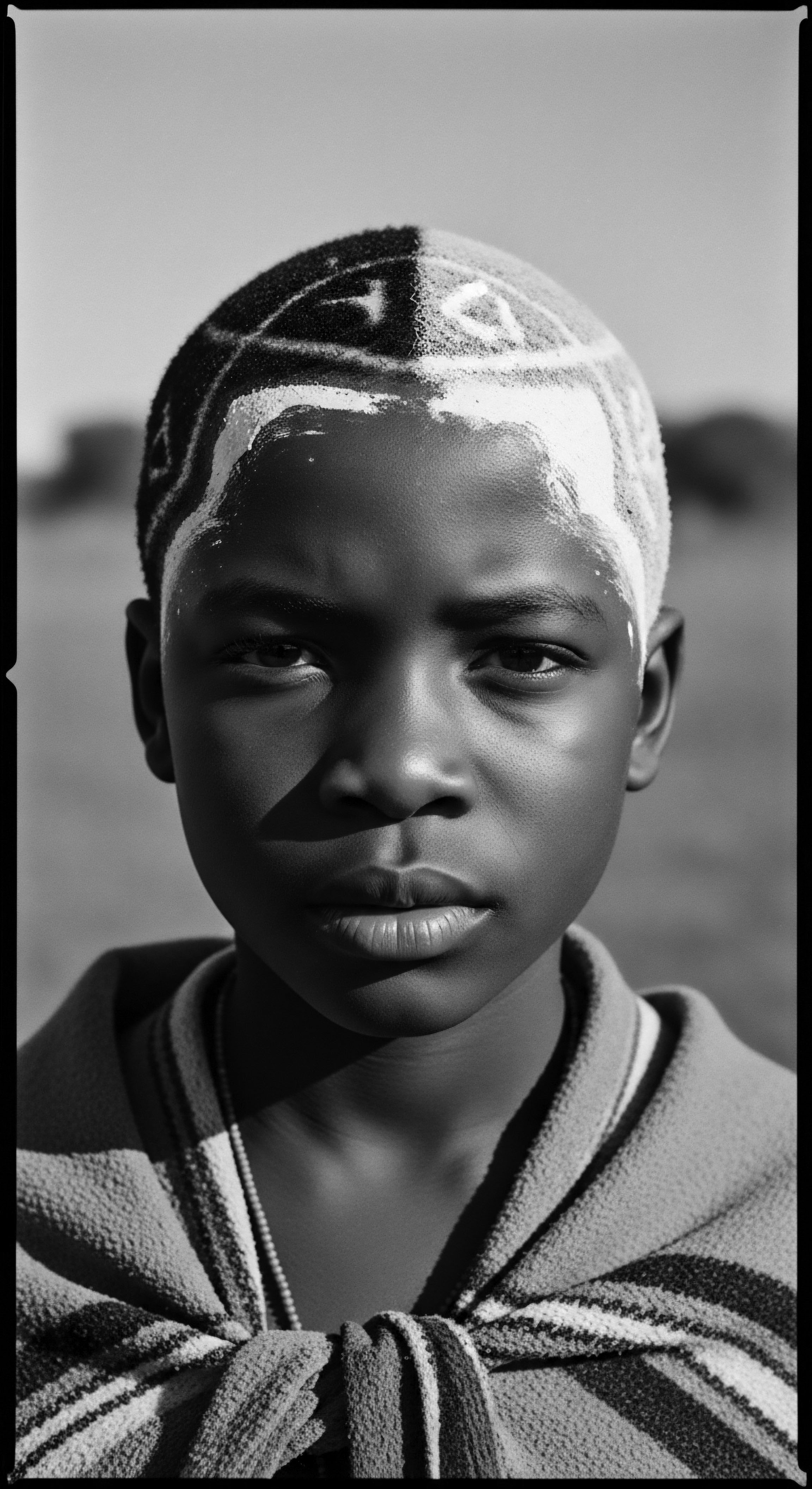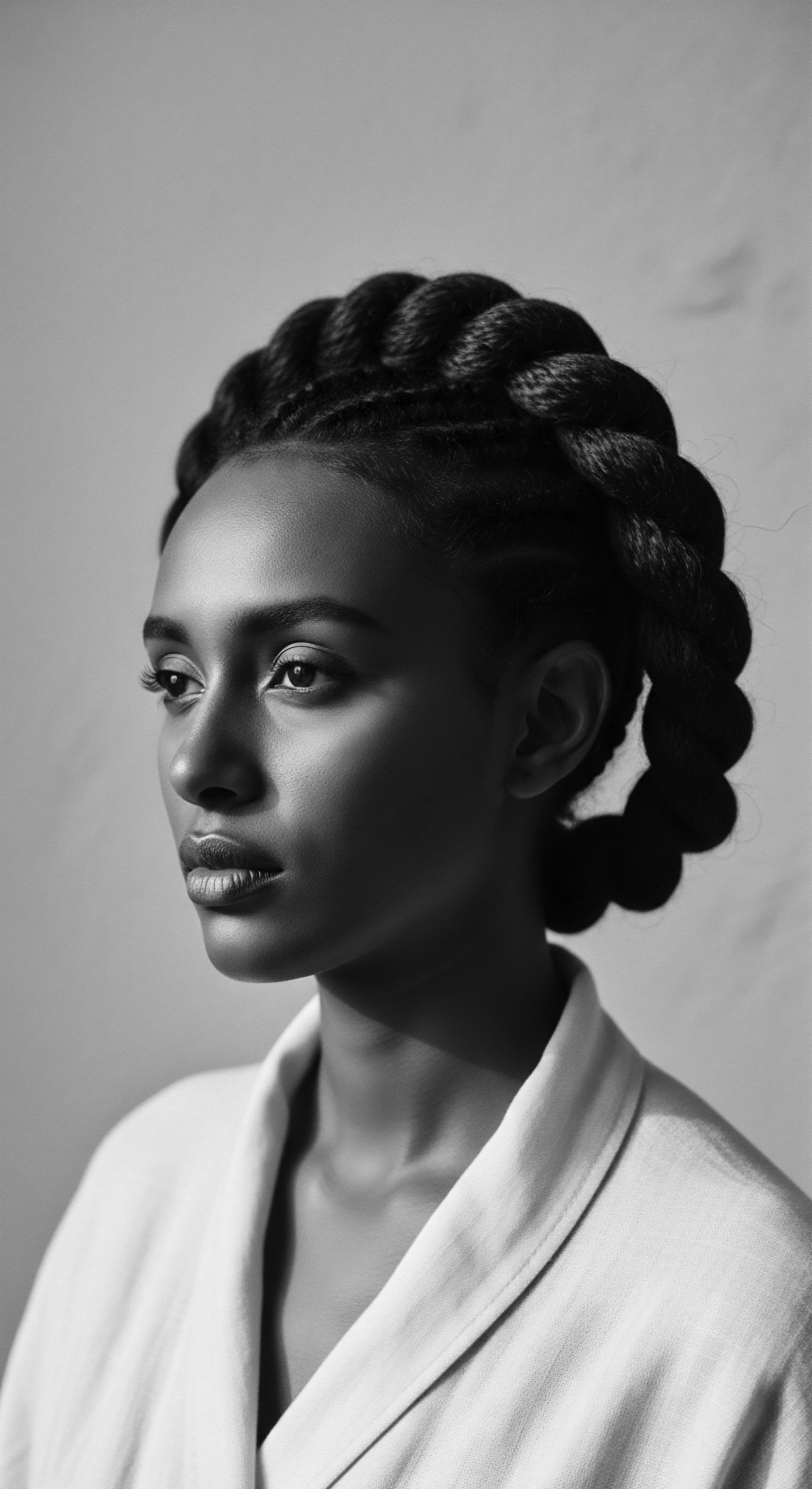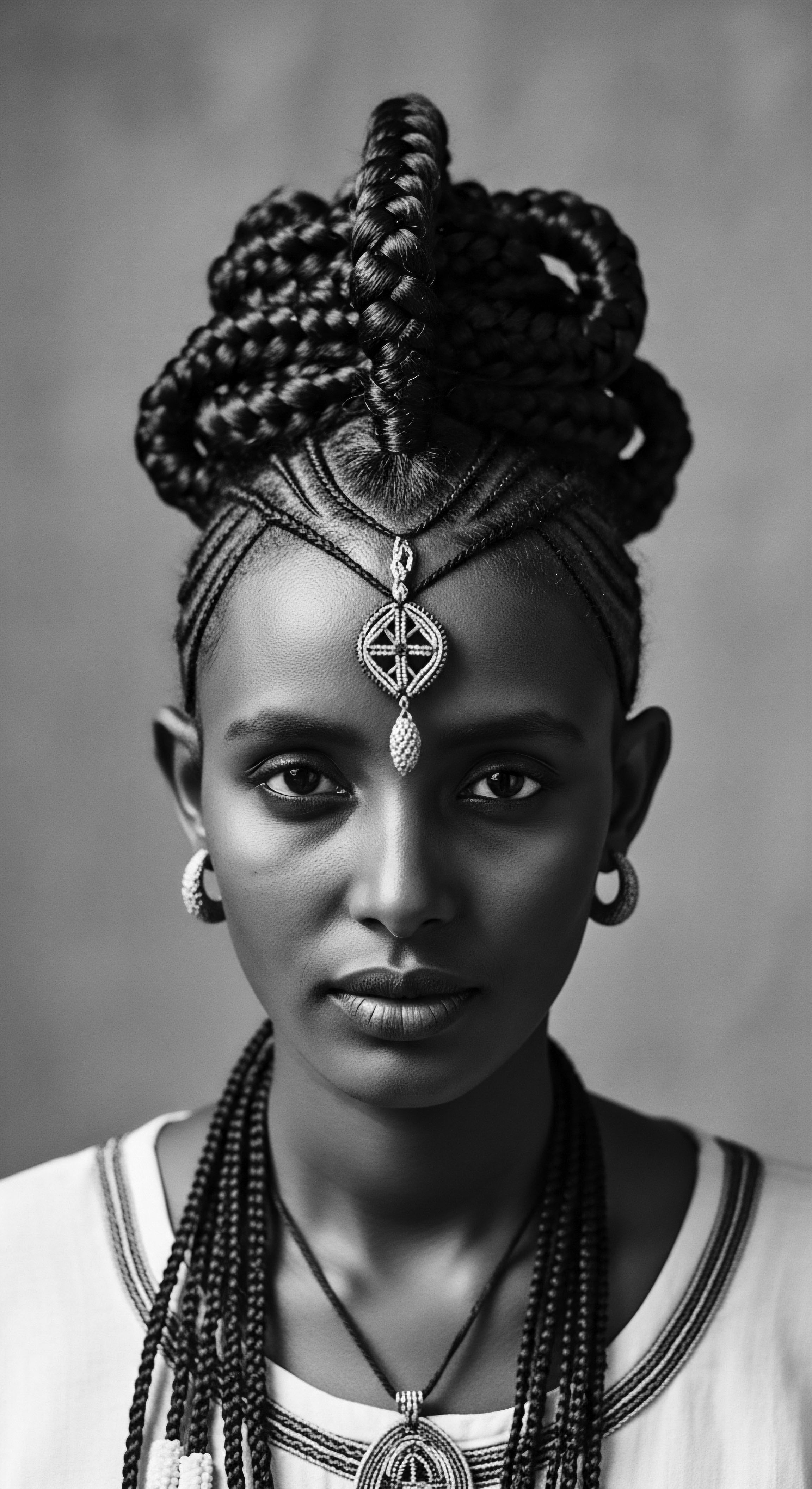
Roots
Across generations, the narratives of textured hair have whispered profound truths. They speak of lineage, of spirit, and of the enduring human will. For descendants of African peoples, particularly those whose forebears endured the brutal currents of the transatlantic trade, hair was never simply an adornment. It served as a silent, powerful ledger, a living testament to memory and belonging.
This understanding demands we look beyond surface beauty, seeking the deeper rhythms, the ancient wisdom held within each coil and strand. What untold stories reside within the very structure of ancestral hair, shaping its resistance and capacity for hidden meaning?
The intricate biology of textured hair, with its unique helical structure and varying curl patterns, naturally lends itself to diverse styling practices. This inherent architecture, an ancestral gift, allowed for styles that were not only aesthetically rich but also deeply functional. Before the horrors of the Middle Passage, African societies possessed highly sophisticated hair traditions.
These were not mere trends; they were central to communal life, serving as visual codes for identity, age, marital status, regional origin, and spiritual beliefs. Each braid, each knot, each intricate pattern was a deliberate statement, a public declaration of who one was and where one stood within the community.
Ancestral hair practices in Africa were intricate systems of communication, weaving identity and social standing into every strand.

How Did Ancient Hair Traditions Shape Cultural Identity?
In many West African cultures, hair was a direct extension of the spirit and a potent symbol of one’s connection to the divine. The head was considered sacred, the closest point to the heavens, and thus, great care was taken in its adornment. Styles varied dramatically from one ethnic group to another, forming a visual language understandable across vast distances.
For instance, among the Yoruba of West Africa, elaborate braided hairstyles, often adorned with cowrie shells or beads, could signify wealth, social standing, or even marital availability. The Fulani people, known for their nomadic pastoralism, wore distinctive braided styles that framed the face and often incorporated silver coins, reflecting their journeys and prosperity (Grier & Grier, 1990).
- Adornment ❉ Beads, cowrie shells, gold dust, and precious metals were often woven into hairstyles, signifying status and wealth.
- Status Markers ❉ Specific patterns indicated social standing, age, marital status, or tribal affiliation within a community.
- Spiritual Connection ❉ Hair was considered a conduit to the divine, with particular styles used in rituals or ceremonies.
These ancestral practices laid a profound foundation for the role hair would play in later centuries. The knowledge of braiding, twisting, and locking was not simply a technical skill; it was a communal inheritance, passed down through the gentle hands of mothers, aunties, and grandmothers. This knowledge, though challenged, would prove remarkably resilient, finding new purpose and deeper meaning in the crucible of forced migration. The inherent strength and versatility of textured hair meant that these complex forms could withstand daily life, and later, the harsh realities of forced labor.

The Journey Across the Waters ❉ Hair as a Memory Keeper
The brutal passage from Africa to the Americas, known as the Middle Passage, sought to erase every vestige of identity from enslaved peoples. Yet, even in the depths of unimaginable cruelty, ancestral hair traditions became an unexpected vessel for survival. Individuals would carry seeds, gold dust, or small provisions woven into their braids, a poignant act of hope and defiance against the stripping away of their humanity (Palmer, 2014). This practice transcended mere practicality; it was a profound spiritual act, a physical manifestation of carrying one’s ancestral home, its soil, its sustenance, and its future within the very strands of one’s being.
These early, desperate acts of preservation speak to the deep-seated cultural reverence for hair as a living archive. The memory of home, of family, of freedom, was literally braided into existence, a silent prayer carried on the head. This initial understanding of hair as a repository of heritage sets the stage for its continued, multifaceted use in the challenging landscape of enslavement. It highlights the ingenuity and resilience that allowed fragments of a vibrant past to be carried forward, often unseen, yet deeply felt.

Ritual
Under the crushing weight of enslavement, the deliberate care and styling of hair transformed from a communal celebration into a silent, potent act of resistance. It ceased being merely a cultural practice; it became a ritual of survival, a clandestine language spoken through the fingertips, a quiet defiance against the dehumanizing forces of bondage. In a world designed to strip away identity and belonging, the act of tending to textured hair became a profound expression of selfhood, community, and an unbreakable link to an ancestral past. How did these forced circumstances compel enslaved people to use their hair as a tool for communication and connection?

The Secret Language of Braids ❉ Maps and Messages
One of the most striking instances of hair as a tool for preservation and resistance comes from the use of cornrows to convey messages and map escape routes. The tightly woven patterns, lying flat against the scalp, became intricate, clandestine cartographies. Enslaved individuals, particularly women, would painstakingly braid routes to freedom, waterways, or locations of safe houses directly into their hair. These ‘maps’ were imperceptible to overseers who dismissed the hairstyles as mere aesthetic choices, failing to comprehend the complex intellectual and strategic thought embedded within them.
Cornrows became clandestine maps, guiding routes to freedom and silently challenging the oppressors’ gaze.
A powerful historical example arises from Benkos Biohó , an enslaved African man who escaped and founded the maroon community of Palenque de San Basilio in present-day Colombia. According to local histories, women in his community and those still on plantations would weave messages into their cornrows, communicating troop movements, escape plans, and the layout of the surrounding terrain. They would even conceal gold and seeds within these styles, the gold for their survival once free, the seeds to cultivate new life in their liberated settlements (Wade, 1993). This act underscores a remarkable blend of practicality and symbolic continuity, ensuring not just immediate survival but the propagation of a new future rooted in freedom.
This practice was not unique to Colombia. Across the Caribbean and parts of the American South, similar accounts exist of hair being used to hide valuables, seeds, or even a few grains of rice for sustenance. The textured nature of the hair, with its ability to hold various items securely within its dense coils and tightly woven braids, was instrumental in these covert operations. It was a natural, often overlooked, fortress.

Communal Care ❉ A Sacred Space of Connection
Beyond communication, the very act of hair care created vital spaces of communal solace and intergenerational knowledge transfer. Gatherings for hair braiding were not simply about aesthetics; they were powerful moments of intimacy, trust, and shared heritage. In these stolen moments, away from the watchful eyes of enslavers, stories were shared, songs were sung, and ancestral wisdom was passed down.
These rituals, often performed under the cover of darkness or during brief periods of rest, allowed enslaved peoples to reconnect with their African lineage. The familiar touch of hands on hair, the rhythmic pull of the comb, the whispered conversations—these moments forged bonds of solidarity and reaffirmed a collective identity that slavery sought to dismantle. Children learned not only how to style hair but also the deeper meanings behind specific patterns and the resilience required to maintain them. This ongoing practice ensured that despite forced migration and cultural disruption, the heritage of hair care continued to be a living tradition.
The shared oiling of scalps, the careful detangling, the methodical creation of braids—these were not chores but acts of tender care, a form of spiritual balm amidst immense suffering. It was a tangible way to preserve a piece of oneself, a fragment of one’s ancestral identity, when so much else was being systematically erased.

Relay
The historical resonance of hair as a vessel for heritage did not dissipate with emancipation; it simply reshaped its expression. The practices honed in defiance of bondage became foundational elements of Black and mixed-race identity in subsequent generations. Hair continued its silent conversation, adapting to new social landscapes while stubbornly holding onto ancestral memory. How did these acts of preservation, born of necessity, persist and transform into enduring expressions of cultural identity?
The intricate techniques of braiding, twisting, and coiling, once clandestine tools, evolved into visible markers of identity and communal pride. From the early 20th century, even as assimilationist pressures mounted, distinct African-derived hairstyles continued to be worn in many Black communities across the diaspora. These styles represented a connection to a past that was not just about pain, but also about profound ingenuity and collective strength.
The legacy of ancestral hair practices persisted, shaping cultural identity and becoming a visible testament to enduring heritage.

Textured Hair ❉ A Living Archive of Resilience
Consider the sheer longevity of styles like cornrows, box braids, and twists. These are not merely fashion statements of the modern era; they are direct descendants of ancient African traditions and the survival strategies forged during enslavement. The continuity of these styles, often passed down from grandmother to mother to daughter, represents an unbroken thread of cultural transmission.
A study by Tatum (2000) highlights how hair practices, even in post-slavery eras, served as vital social anchors. In many African American communities during the Reconstruction era and beyond, Sunday church services were occasions where individuals showcased their meticulously cared-for hair, often styled in patterns that echoed ancestral forms. This public presentation was an act of self-respect and cultural affirmation in a society that continued to denigrate Black bodies and identities. The statistic of consistent presence of braided styles in community gatherings speaks to the quiet, pervasive power of heritage.
| Era and Context Pre-Colonial Africa |
| Primary Function of Hairstyles Social status, spiritual connection, tribal identity, communication systems. |
| Heritage Connection Direct lineage, cultural affirmation, communal bonding. |
| Era and Context Enslavement Period |
| Primary Function of Hairstyles Hidden communication (maps, messages), concealment of valuables (seeds, gold), communal solace, quiet resistance. |
| Heritage Connection Survival, defiance, preservation of knowledge and future potential. |
| Era and Context Post-Emancipation to Mid-20th Century |
| Primary Function of Hairstyles Markers of self-respect, community identity, subtle cultural affirmation amidst assimilation pressures. |
| Heritage Connection Continuity of tradition, assertion of identity in a hostile environment. |
| Era and Context Modern Era (Natural Hair Movement) |
| Primary Function of Hairstyles Self-acceptance, cultural pride, political statement, wellness advocacy, ancestral reconnection. |
| Heritage Connection Reclamation of narrative, celebration of inherent beauty, holistic well-being linked to ancestry. |
| Era and Context Hairstyles have consistently served as a powerful conduit for ancestral knowledge and resilience across distinct historical periods. |

How Do Contemporary Styling Choices Reclaim Ancestral Narratives?
The resurgence of the natural hair movement in recent decades represents a conscious reclamation of this ancestral heritage. Individuals are increasingly choosing to wear their textured hair in its natural state or in protective styles that honor the ingenuity of their forebears. This choice is often rooted in a desire to connect with a lineage that predates colonial impositions and to challenge Eurocentric beauty standards. It marks a shift from seeking acceptance through conformity to celebrating intrinsic beauty and cultural distinctiveness.
Modern natural hair care practices, while benefiting from scientific advancements, often echo ancestral wisdom. The emphasis on gentle handling, moisturizing, and protective styling aligns with traditional methods that understood the unique needs of textured hair. The ingredients used in some contemporary products—shea butter, various plant oils, traditional herbs—often mirror those used in African communities for centuries, creating a tangible link to ancient beauty and wellness rituals.
- Conscious Styling ❉ Choosing natural textures and protective styles as an act of self-acceptance and cultural affirmation.
- Ingredient Lineage ❉ Seeking out natural ingredients with historical usage in African and diasporic hair care.
- Knowledge Transfer ❉ The proliferation of online communities and resources dedicated to sharing natural hair care tips, often drawing parallels to ancestral practices.
The act of braiding a child’s hair today, explaining the significance of a particular style, or simply sharing stories while styling, continues the living tradition of hair as a relay point for heritage. It is a quiet, yet potent, act of transmitting cultural memory, ensuring that the ingenuity and resilience of enslaved ancestors are not only remembered but actively lived and celebrated in the present moment. This daily engagement reinforces the profound connection between personal identity and collective ancestry, anchoring individuals in a rich and enduring cultural story.

Reflection
The journey through the intricate ways enslaved people used hairstyles to preserve heritage reveals a profound truth about the human spirit. It is a testament to the fact that even in the face of unimaginable oppression, creativity and connection find a way to persist. The coils and kinks of textured hair became not merely strands but conduits for memory, rebellion, and a relentless hope for continuity.
This deep connection to our ancestral hair is more than a historical footnote; it is a living, breathing archive, each strand a fiber in the ‘Soul of a Strand’—a testament to resilience, a blueprint for liberation, and a constant reminder of the vibrant heritage that flows through us. As we honor these stories, we also honor the enduring power of heritage itself, recognizing that the past is never truly gone but lives on, beautifully, within us.

References
- Byrd, A. D. & Tharps, L. L. (2001). Hair Story ❉ Untangling the Roots of Black Hair in America. St. Martin’s Press.
- Grier, K. A. & Grier, P. L. (1990). African American Hairstyles ❉ History and Trends. Smithsonian Institution Press.
- Palmer, S. (2014). Freedom on the Move ❉ North Carolina’s Underground Railroad. The University of North Carolina Press.
- Tatum, B. D. (2000). “Why Are All the Black Kids Sitting Together in the Cafeteria?” And Other Conversations About Race. Basic Books.
- Wade, P. (1993). Blackness and Race Mixture ❉ The Dynamics of Racial Identity in Colombia. The Johns Hopkins University Press.
